By Joanne Wharam, AVN Practice Growth Expert
How DiSC profiling works and how the measure of the four factors of personality explains the ‘language’ we speak.
I am confident that as an accountant in practice, there will be times when you find it hard to motivate yourself to do certain tasks. You might feel overwhelmed or struggle prioritising. Sometimes you might simply feel that you are speaking a different language to the person you are talking to.
How can I say that with confidence?
The main reason is my years of experience as a certified DiSC practitioner and Business Coach.
You see all of those challenges I mentioned above are influenced by our personality and behaviours – and that is exactly what DiSC profiling assesses.
What is DiSC profiling?
DISC was originally presented by Professor William Marston in his 1928 book Emotions of Normal People. It measures four unique areas, that make up the DISC acronym:
D (Dominance) measures problems and challenges.
I (Interpersonal) relates to people and contacts.
S (Steadiness) measures a person’s inclination toward pace and consistency.
C (Compliance) measures procedures and compliance.

How does a DiSC assessment work?
A DiSC assessment typically asks around 24-30 questions and is essentially assessing the pace and focus of individuals.
Pace
This is about whether an individual is more outgoing and comfortable working at a fast pace or prefer to be a little more considered and work at a more measured pace. Fast paced people are generally more assertive and dynamic whereas those with a more measured pace tend to be more careful and patient.
Focus
This is about whether an individual is more concerned with getting a task done or the people that they are working with or for. Task focused people are questioning and have strong technical abilities whereas those with a stronger people focus are more interactive and are concerned about what others think.
It measures the balance of the four traits or categories and results in the test taker being placed in one of four clearly defined personality types, labelled using the letter of the most dominant of the four traits either “D”, “I”, “S” or “C”.
The 4 core DiSC profiles
D – Fast pace – Task Focus
These profiles are concerned with results and are by nature driving, demanding, and decisive characters. They love to be in charge and thrive on competition. You will spot them because of their self-confidence and directness in their communication.
I – Fast pace – People Focus
These profiles are concerned with relationship building and are by nature interactive, inspirational and impressive. They love group activities and thrive on social recognition. You will spot them because of their enthusiasm and sociability, they love to talk and share personal stories and feelings.
S – Measured pace – People Focus
These profiles are concerned with being of service and are by nature supportive, sincere and shy. They love to be able to help and make brilliant team players. You will have to pay attention to spot them as they don’t like the limelight but can recognise them by their calm approach and patience.
C – Measure pace – Task Focus
These profiles are concerned with quality and facts and are by nature cautious, competent and contemplative. They love to be able to gain new knowledge and share their expertise. Again you will have to pay attention to spot them as they prefer to get their head down and get on with the task at hand but you can recognise them by their questioning scepticism and perfectionism.
How to apply DiSC in your accountancy practice
DiSC is three dimensional and all three dimensions can benefit a business.
First dimension – this is about understanding yourself better, the language you speak in terms of your profile.
Second dimension – you can use knowledge of the different DiSC profiles to start to understand what might make others tick.
Third dimension – you can use the combined knowledge of your DiSC profile and the profile of the other person you are working with (or even selling to) to apply the ‘platinum rule’ of treating others how they want to be treated.
When you apply DiSC within your practice you can address all three dimensions. This will help you with your team in two key ways:
- Increased motivation and employee engagement. By understanding what people are good at and what stresses them you can adapt things to ensure that their balance of work is one that is enjoyable to them increasing motivation and engagement. Also, better understanding of each other strengthens working relationships which increases team cohesion and adds to motivation and engagement.
- Increased productivity. When you understand strengths and what stresses them you can either delegate the right responsibilities to the right person in the team (or outsource if you don’t have the right person to give it to). Not only are people more motivated as mentioned above, but they will also get through the work a lot more efficiently which increases productivity.
- Improved recruitment. It is possible to profile a job role to identify the skill set and profile of the ideal candidate. You can then compare this to assessments done by short-listed candidates to determine whether they actually have the skills you need. This means you are not relying solely on what they have told you they can do.
So, in summary DiSC is a hugely valuable tool that can help you to maximise your own potential, that of your people and consequently your practice.
How we use DiSC profiling at AVN
At AVN, we run a DiSC profile on all the accountants we work with to make sure we understand you and communicate with you in the way you want. Want to know more? Book a discovery call with one of our team – book here.
Photo by Felicia Buitenwerf on Unsplash
Recent Comments